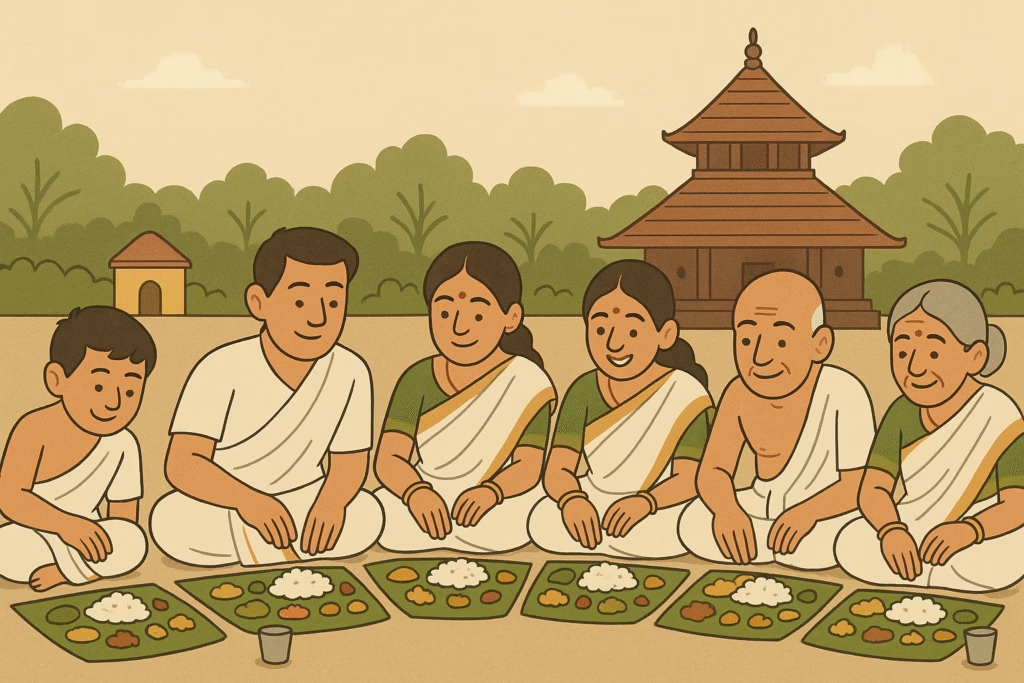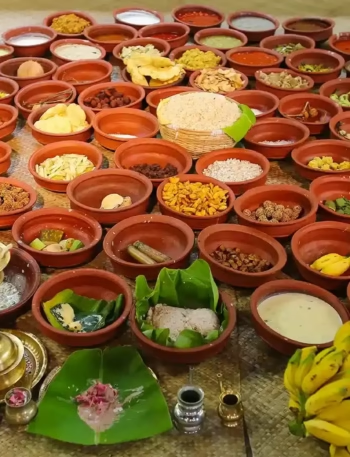The Konkani-speaking community in Kerala, primarily represented by the Goud Saraswat Brahmins (GSBs), embodies a unique gastronomic heritage shaped by migration, religious orthodoxy, and regional assimilation. While their ancestral roots trace back to the banks of the Saraswati River and later to Goa, their resettlement along Kerala’s Malabar coast has resulted in a distinctive culinary tradition. This blog post examines the Konkani food culture of Kerala through a cultural-historical lens, analyzing its characteristic features, ritual significance, and adaptations, thereby highlighting food as a vital marker of ethnolinguistic identity and continuity.
Historical Context and Migration Patterns
The origins of the Konkani people can be traced to the now-extinct Saraswati River basin. When the river dried up, waves of migration were initiated that took Konkani communities to various parts of India. Some migrated northwards to Kashmir-eventually evolving into the Kashmiri Pandits-while others moved eastward to Bihar, where they integrated with communities such as the Kanyakubja, Maithili, and Saryupareen Brahmins. A significant portion migrated southward, traveling via Dwaraka and arriving in Goa (Gomantaka) by sea. The Saraswat Brahmins, a prominent Konkani group, are believed to have settled in Goa in successive waves, with major settlements dating as far back as 1000 BCE.

These migrations laid the foundation for a resilient and adaptable food culture. The Konkanis developed a distinctive culinary identity by absorbing and integrating local food practices from the diverse regions they traversed, while also transmitting their own culinary knowledge. In this process, ingredients such as coconut, fish, and rice became staples in regions like Goa and coastal Karnataka. In contrast, Kerala and interior Karnataka witnessed a predominance of vegetarian traditions among Konkani Brahmins, influenced by temple rituals and regional agrarian customs.
Their food culture reflects deep adaptation. In regions abundant in coconut trees, such as Goa and Kerala, coconut found multifaceted culinary use. In Goa and Maharashtra, many Konkani Brahmins adopted a pescatarian diet, incorporating seafood as an essential component, often described as “sea vegetables” in local lore. The Goan Konkani kitchen also absorbed Portuguese influences, leading to the development of unique dishes such as hooman ani xit (fish curry and rice), and festival foods like khatkhate, a mixed vegetable stew.
Ingredients and Culinary Techniques
Kerala-based Konkani cuisine remains predominantly vegetarian, with regional adaptations evident across the coast. Coconut (grated, milk, and oil), mustard seeds, curry leaves, green chilies, tamarind, kokum (bindasol), jaggery, and asafoetida (hing) are foundational ingredients. In Goa, unique souring agents such as kokum and raw mango dominate, along with spices like triphal (Sichuan pepper), fenugreek, and coriander seeds.
Food preparation reflects both Vedic ritualism and regional ecology. Traditional tools such as grinding stones (ammi kal) and clay pots (mann chatti) are still used in many households. A defining principle in ritual cooking remains the absence of onion and garlic, in adherence to Brahminical dietary codes.
Migration and environmental adaptation made food preservation central to Konkani life. Pickling, drying, and fermentation emerged as practical and cultural necessities-methods that enabled food security during uncertain travel and harsh monsoons. Common pickles (nonche or lonche) include raw mango (ambuli), lemon, bilimbi (bibbla), and hog plum (ambade). Dried goods such as ambusti (dried mango), panas poli (dried jackfruit), and vadis (sun-dried lentil cakes) ensured continuity of flavor and nutrition.
Signature Dishes and Their Symbolism
The Konkani culinary lexicon is rich and varied, with dishes symbolizing not only sustenance but seasonal rhythms, ritual life, and intergenerational knowledge:
- Dalithoy: A simple yet emblematic preparation of toor dal tempered with mustard seeds, asafoetida, and green chilies-often considered the soul food of Konkanis.
- Pathrado: Made from colocasia leaves smeared with spiced rice and coconut batter, then steamed and sometimes pan-fried. This dish demonstrates both foraging wisdom and culinary adaptation.
- Tendli Bhath: A spiced rice dish prepared with ivy gourd, commonly offered during religious functions.
- Madgane: A festive dessert comprising chana dal, jaggery, and coconut milk, made especially during Janmashtami and Ugadi.
- Sol Kadhi: A refreshing digestive drink from the Konkan belt, made with kokum and coconut milk.
- Modak and Nevri: Sweet dumplings filled with coconut and jaggery, prepared during Ganesh Chaturthi and other festivals.
- Upkari: Dry stir-fried vegetables cooked with mustard and grated coconut, exemplifying simplicity and balance.
- Kelye Ambat: A sweet-spicy curry made from ripe bananas, illustrating inventive uses of tropical produce.
These dishes transcend sustenance, anchoring memory, spirituality, and community identity.
Ritual and Religious Dimensions
Food in the Kerala Konkani context is deeply ritualized. Temples, especially in Kochi such as Gosripuram and T.D. Temple, play pivotal roles in maintaining culinary traditions. Festival cooking follows strict codes-right from selecting utensils to chanting mantras while preparing naivedyam (sacred offerings). Dishes like panak, tambuli, and madgane are reserved for sacred occasions.
The performance of food rituals underscores religious orthodoxy and sustains intergenerational continuity. Cooking for deities, especially during festivals, becomes a deeply symbolic act, blending devotion with domestic practice.
Interactions with Regional Cuisines
Konkani cuisine in Kerala showcases both assimilation and distinction. While absorbing local vegetables like ash gourd (kumbalanga), yam (chena), and banana (nendran), the GSBs maintained distinct culinary principles. Unlike the elaborate sambar and avial of Malayali cuisine, Konkani preparations are often subtler in seasoning but richer in coconut and lentils.

There is also an active exchange of culinary techniques. Dishes like valval (a coconut-based stew with vegetables like drumsticks, ash gourd, and potatoes) and randayi (a coconut and lentil-based curry) reflect a mutual influence between communities while preserving Konkani core values.
Contemporary Dynamics and Culinary Preservation
In modern Kerala, Konkani food culture faces both erosion and revival. Nuclear families, changing work patterns, and urban lifestyles have altered cooking habits. However, the community has responded with initiatives that document and share traditional recipes-blogs, YouTube channels, and oral history projects.
Cultural events like Konkani food festivals and temple annadanam continue to function as public spaces of preservation. Within families, food remains a living archive, especially during festivals and rites of passage. Traditional skills like making papads, pickles, and vadis are passed on, often through the mentorship of elder women.
The culinary tradition of the Konkani community, particularly in Kerala, is a remarkable case study in cultural resilience. Forged through centuries of migration, adaptation, and integration, it embodies a living dialogue between history, geography, and identity. From river valleys to coastal plains, from foraged greens to temple offerings, Konkani food culture is more than a repertoire of dishes-it is a narrative of survival, sanctity, and celebration. In preserving it, we preserve a vital strand of India’s pluralistic heritage.



